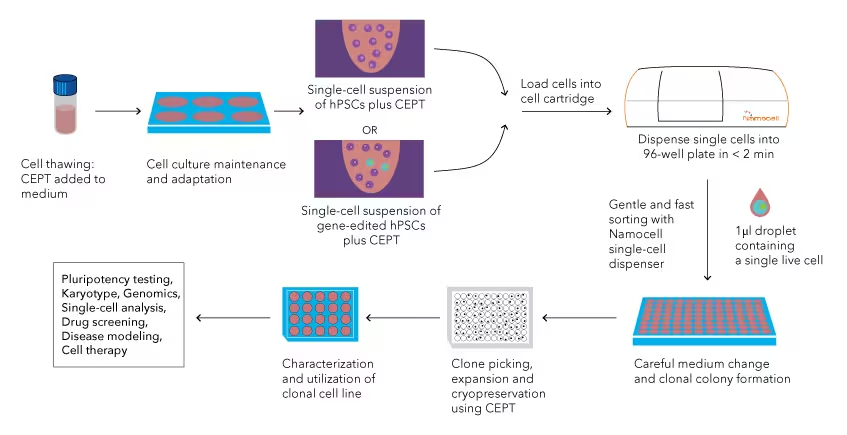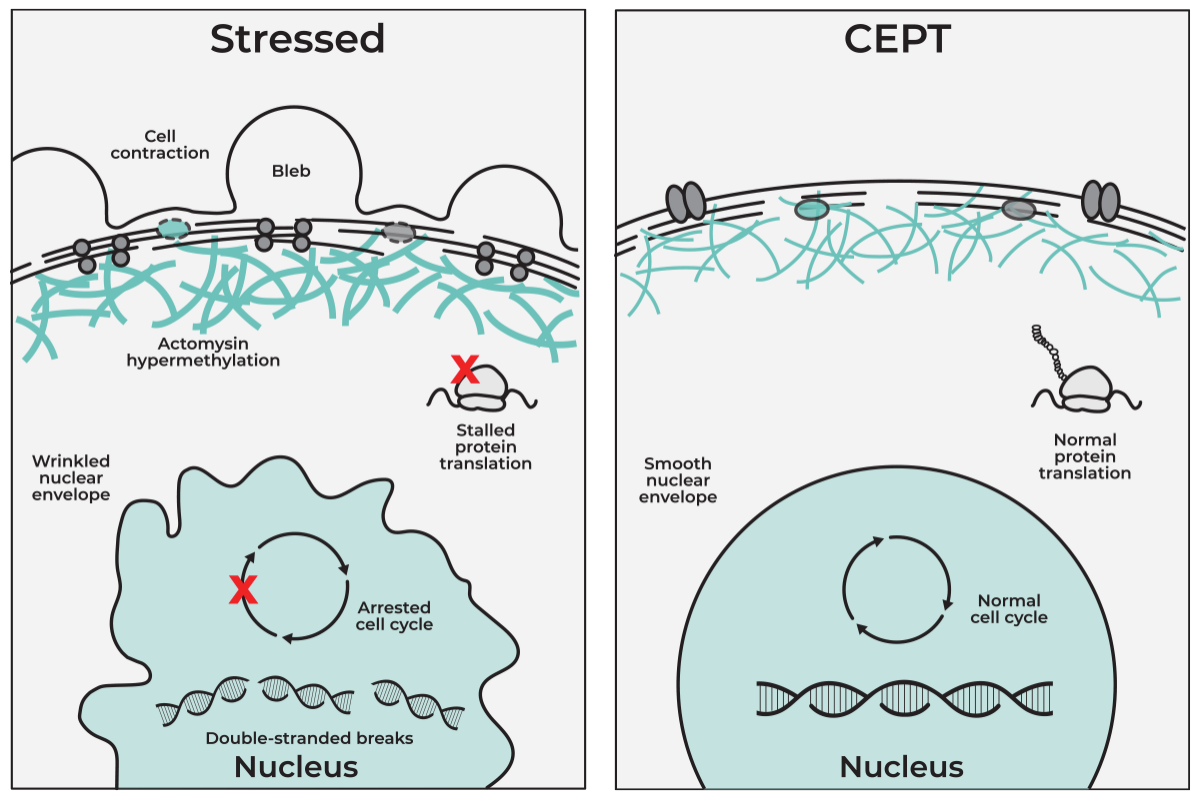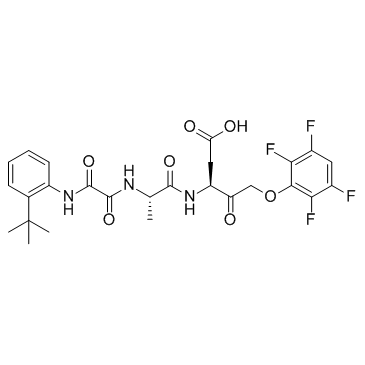CEPT Cocktail
CEPT, the combination of Chroman 1, Emricasan, a Polyamine solution, and Trans-ISRIB, has been found to secure several applications in research, regenerative medicine, cell therapy, cryobiology, and drug development to enhance the viability and expansion of human pluripotent stem cells in culture or to upgrade the functionality of multiple derived cell types. A novel incentive, high-throughput targeted screening, and determination of compounds can be done with augmentation of CEPT small molecules as cell culture reagents to withstand the challenge of employing stem cells in basic research and therapeutics.

Figure 1: shows the structure of CEPT Cocktail components.
Human pluripotent stem cells (hPSCs) have substantial self-renewal capability in culture in addition to their sensitivity in vitro environment during stressful cell culture manipulations or dissociation during routine passaging as single-cell or in clonal culture, frequently inducing deprived cell survival. A secure, productive, and controlled framework is required for the clinical translation of hPSCs employing large-scale production, cell culture expansion, clonal manipulation, cryopreservation, and directed differentiation.
Let’s explore the mechanism of actions of each component of CEPT Cocktail buffer.
Chroman 1:( C24H28N4O4.2HCl), It’s molecular weight is 509.43 and it is a potent inhibitor of ROCK (rho-associated coiled-coil kinase). Chroman 1 affects the Wnt, TGF-beta/Smad pathways and acts as a cytoprotectant for pluripotent stem cells under stress.
Emricasan:(C26H27F4N3O) ,It’s molecular weight is 569.50 and it is a pan caspase inhibitor, and inhibits caspase 1 and 8, caspase 1 initiates inflammatory cascade and caspase 8 induces hepatocyte apoptosis.
Trans ISRIB:(C22H24Cl2N2O4), It’s molecular weight is 451.34.ISRIB reverses comprehensively and specifically the effects of eIF2α phosphorylation.
CEPT Cocktail utilizes the enrichment of small molecules to rectify the survival of pluripotent stem cells at all stages of stem cell research, conducting a poly-pharmacological strategy. This blend of small molecules is a compelling approach to be used in cryopreservation, routine long-term passaging, single-cell cloning, gene editing, differentiation, embryoid body, and organoid formation. CEPT Cocktail offers advancements in cryopreservation in stem cell research compared to currently accessible reagents by enabling cell adhesion and relieving cellular stress and DNA damage during passaging.

Figure 2: depicting the areas where we can use CEPT Cocktail
Chroman 1 is a robust and selective ROCK1/2 inhibitor, found to be more effective than the most widely used ROCK inhibitor for stem cell cultures, Y27632. Chroman 1 results in inducing similar progress in the viability of cells used at 50 nM as Y27632 in the regular application of 10 µM, displaying no inhibition of off-target kinases at 50 nM. Also, Chroman 1 can be used as an unscathed supplement in long-term cell cultures. Through single-cell dissociation, cells cultured with Chroman 1 within the first 24 hours remained karyotypically normal after 40 passages. The cultures depict distinctive morphology and detailed expression of pluripotent markers while maintaining the differentiation capacity of stem cells into endodermal, mesodermal, and ectodermal lineages.
Chroman 1 works in cooperation with Emricasan for the improvement of cell survival. For this, a combinatorial matrix screening strategy was adopted, with the implementation of Chroman 1 to identify synergistic compounds that ultimately enhance cell survival. The most compelling combination with Chroman 1 was found, Emricasan, determined as a pan-caspase inhibitor results in the progression of cell survival by either using Chroman 1 or Y27632 solely. A considerable increase in the number of viable cells was noticed due to the treatment of cells with Chroman 1 and Emricasan following single-cell dissociation, resulting in cells being karyotypically normal after dissociation as single cells for 40 passages.
The consequences of Chroman 1 and Emricasan under harsh conditions, such as ultra-low cell densities advanced with supplemental screening of specified compounds, which permits secured and competent cell passaging and clonal expansion. Trans-ISRIB, a particular small molecule integrated stress response (ISR) inhibitor employs a critical role in the regulation of the translation of proteins to ascertain notable advancement for cell survival by cooperating with Chroman 1 and Emricasan. The augmentation of polyamines with the Trans-ISRIB compound elevates cell attachment and protein synthesis during cell passaging. The supplementation of Chroman 1 (50 nM), Emricasan (5 mM), and Trans-ISRIB (0.7 mM) small molecules in culture media with Polyamine solution encourages the growth and development of clones and genetically stable hPSCs.
To understand long-term passaging, before meticulous research, eight hPSC lines were cultured with CEPT (exposed to cells for 24 hours at each passage) to sustain healthy, pluripotent cultures. No changes were seen by whole exome sequencing and genetic analysis during cell passaging with CEPT for 20 passages, the majority of cells remain undifferentiated and retain normal karyotypes with the capability of directed spontaneous differentiation.
Cells are exposed to a variety of cultural conditions to indicate that the impact of CEPT on improved cell survival is self-reliant on the cell line (hESC or hiPSC), media composition (E8, StemFlex, mTeSR, StemFit, MEF-conditioned medium), or coatingsubstrate(vitronectin,Matrigel, laminin-521).
The CEPT Cocktail offers extensible single-cell cloning of hPSCs and the production of clonal cell lines by fusing it with the microfluidics-based cell sorting instrument Hana (from Namocell, a Bio-Techne brand), amending challenges regarding single-cell dissociation and clonal cell line establishment in basic and translational stem cell research. While CEPT Cocktail sustains pluripotency and enhances single-cell cloning, Hana employs automated (<2 psi) cell dispensing to attenuate cell damage and mechanical stress.

Figure 3: demonstrating single-cell cloning of hPSCs with CEPT and Namocell
Embryoid bodies (EBs) and self-organizing organoids emanating from human pluripotent stem cells (hPSCs) reiterate tissue development, which is a significant commitment for disease modeling and drug development. Nevertheless, during cell aggregation recent standards are hindered by cellular stress and apoptosis, which leads to variability and compromised cell differentiation. With small molecule CEPT (Chroman 1, Emricasan, Polyamines, Trans-ISRIB), a polypharmacological practice that certifies cryoprotection and cell survival can be used to maximize EBs and various organoid models (e.g., brain, gut, kidney). During cell aggregation, the employment of CEPT for 24 h has everlasting outcomes that influence morphogenesis, gene expression, cellular differentiation, and organoid function in various ways. In comparison to the widely used ROCK inhibitor Y-27632, CEPT enriches practical reproducibility and enhances EB or organoid bodies' wellness substantiated through several qualification methods. Therefore, with the influence of CEPT, we uncovered that stress-free cell aggregation and cell survival are essential quality control determinants that are designated as potent frameworks for bioengineering complex tissue and organ models.
The wellness of cells is sustained by the moderation of pathways of cellular stress or by variation of cell structure and function-based mechanisms with the assistance of CEPT Cocktail. The complicated or interrelated mechanism of action of the CEPT Cocktail includes the impedance of cell contraction directing apoptosis, sustenance of nuclear circularity, guarding cells from DNA damage, averting from cell cycle arrest, reforming protein synthesis or translation experience, enhancing cell-cell and cell-ECM interactions and lessening oxidative stress on cells. The extensive conservation of the cells is necessary, especially during stressful cultural conditions to culture hPSCs or other types of susceptible cells that face difficulty in withstanding stressful conditions, such as single-cell passaging, gene editing, differentiation, or cryopreservation.

Figure 4: demonstrating how does the CEPT cocktail overcome cellular stress
The general cooperation of the CEPT Cocktail permits protective and improved stem cell passaging and clonal expansion from low densities, resolving the challenges of translational stem cell research. Although there is no accord with the most promising method for routine passaging of hPSCs and cell survival, with the supplementation of the CEPT we can promise a more standardized, productive, and compelling approach for hPSCs culture. The CEPT cocktail fosters exceptional cell survival through its ability to alleviate stress during the critical phase of cell aggregation, thereby designating a potential for future applications. CEPT Cocktail facilitates more reliable and consistent differentiation of hPSCs into complex tissues and organoids which ultimately accelerates advancements in regenerative medicine and drug discovery.
















Comments